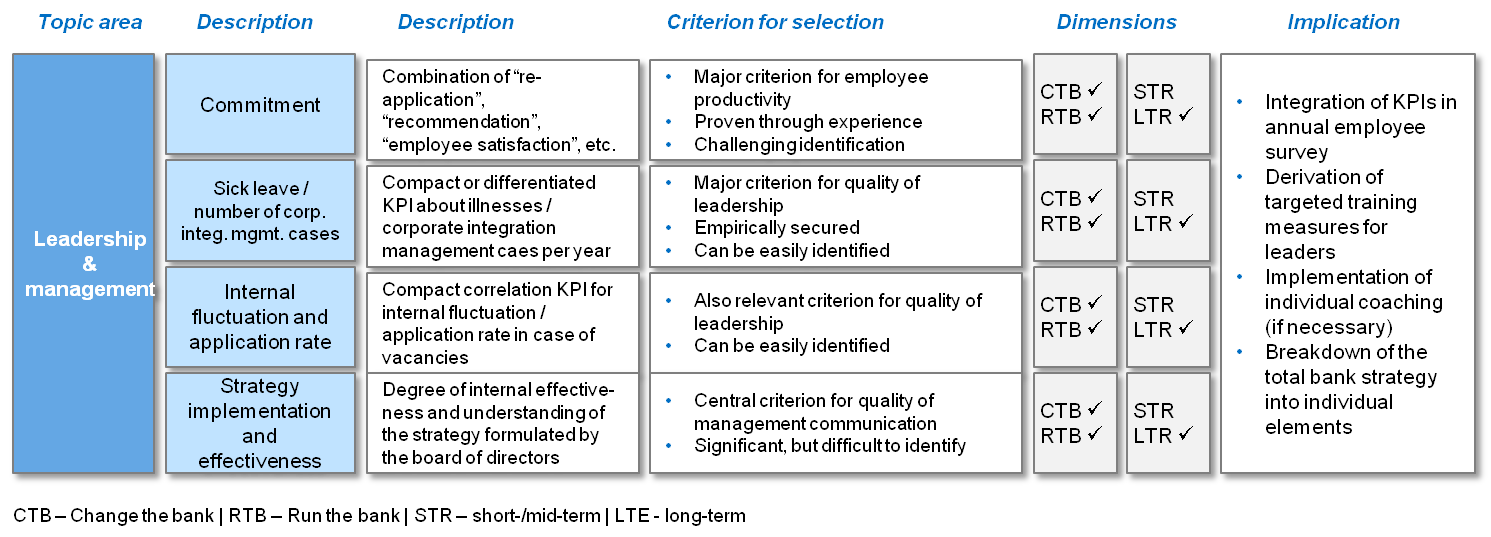Well-educated personnel is key for all outsourcing and rationalization options
Adequate, sufficiently qualified and well-educated personnel is key for all outsourcing and rationalization options. However, it isn’t enough anymore to buy in highly qualified IT or Business Administration specialists from the market or universities. Qualifications across all disciplines are required in many IT roles and indicate a high and continuous (further training) need of comprehensive and interdisciplinary skills.
Business architects, especially at financial services providers, have to be able to integrate technical and IT requirements of the private and corporate customer business, regulations or the total bank management. Thus, in addition to typical IT qualifications, not only a certain level of banking expertise is necessary, but also an excellent methodological know-how. This applies to the business process analysis, the design of a concept as well as moderation.
A similar complex requirements profile arises for IT project managers. Apart from sound IT expertise, the internal client expects as well, of course, significant project management know-how, but also—ever more often—skills above average in communication, resource management or conflict resolution. Other prominent IT roles in credit institutions show similar demanding requirements profiles.
This applies for application developers, specialists for IT infrastructure or IT administration, even for staff employees in larger IT organizations, this means experts, who are responsible for IT controlling, finance and employees in information technology. Especially in times, when IT areas of banks and insurances are to become more concise and efficient, requirements for the personnel in information technology of these companies will increase as well. An active positioning or ORG/IT as a stakeholder instead of a pure supplier for the divisions requires in particular highly qualified employees with good communication skills in order to develop and provide solutions optimized for the division.
With a view to the increasingly high differentiation degree of technical and interdisciplinary qualifications in ORG/IT, it is inevitable to establish role-based qualification programs sooner or later, specific for business architects, project managers, application developers and other IT specialists with the respective relevant technical and interdisciplinary education contents. There are still significant additional requirements at financial services providers, that still frequently refer to common qualification concepts and central HR management.
Specific qualification concepts for ORG/IT employees
There are good and proven programs on the market which fulfill these specific requirements. Here, the project management qualifications of IPMA/GPM and PMI or the programs of ITIL are to be mentioned. The different requirements and certification levels of these or similar programs reveal a significant need in terms of personnel in the IT organizations of modern credit institutions: highly-skilled employees with development potential are averse to a silo mentality which still applies to most of the banks. The old paradigm of an industrial society “leadership is the only way to get ahead” is usually not viable in dynamic and performing IT organizations. It becomes ever more difficult in the conservative structures to gain top performers as employees and the interest conflicts of a silo mentality often jeopardize success of complex projects.
Thus, career models with “multiple” career paths are to be established for a sustainable positioning of ORG/IT. It is not enough to establish the career path of a technical, leadership and project career, that have often been described in literature. It is rather about designing a career model that corresponds to the business model (or operating model) of IT organization and is put into practice. This means, a career model has to be developed that contains independent career paths, such as “business architect”, “project management”, “application development”, “service management”, etc. These career paths should, in return, comprise different career levels (seniorities): from junior to principal—and so the link to the aforementioned qualification architectures is established.
An example for the successful implementation of such a model in IT organization is Commerzbank AG. Here, all relevant design principles have been considered for such a career model.
- Orientation towards business model
- Balance of stability and change A structural balance between changing roles and requirements on the one hand as well as fixed personnel structures (career level) on the other hand should be created.
- Integration in a personnel overall concept A career model is only functional, if both qualification and remuneration aspects are equally and consistently considered.
- Equality and permeability The career paths must have the highest possible level of equality and permeability in order to prevent a relapse into “silo careers”.
- Transparency and profitability The career models are to be understandable for all employees and must not create excessive maintenance.
Such a demanding personnel concept requires a consistent and specific management, this means it should be directly applied by IT management or CIO. A central concept management has proven to be not expedient, since the personnel areas don’t have much in common with the specific topics of ORG/IT and concepts—that work well for the other areas of banks—cannot be transferred without further ado.
HR management in ORG/IT with the IT scorecard
For reasons of performance and investment protection, it is recommendable to establish the “HR dimension” apart from the hard factors as integral part of the IT scorecard. No leadership and personnel concept can be considered successful, if highly skilled employees leave the organization, give up or stop advocating the best possible ORG/IT solution. The following dimensions and components are to be managed in order to prevent this from happening:
- Direct and indirect leadership
- Personnel resources (according to performance, availability, demographic data, etc.)
- Qualification and development processes
- Budgets
What does management mean in this context? “Rationality protection of the leadership” is an ideal buzzword: The leadership of IT organizations in banks is to have indicators and parameters for deriving incentives for action in a sound and reliable way. This comprises in particular decisions about the personnel equipment of an IT organization, about specific qualification needs, about the recruiting of special target groups, etc.
Key figure systems present a valuable contribution within an IT scorecard. These systems cannot replace management decisions, but contribute to decision-making in a structured way and based on transparent criteria. A decisive prerequisite is, however, that the system provides sound, understandable and practicable data which is accepted amongst the leaders and decision makers. Thus, data has to be collected with reasonable effort and must indicate real circumstances, besides its origin and development have to be transparent. In addition, the underlying target values have to match the ideas of the leaders and are to be accepted by them.
The “leadership” and “employee” perspective have to be covered for covering the personnel dimension within the IT scorecard. While the leadership perspective aims at leadership quality and resource management, the second perspective focuses on the skills and qualification of employees. Moreover, the KPIs are also to encompass the two dimensions necessary for management. Both short-term as well as long-term effects have to be recorded and required topics are to be covered for both “run the bank” as well as “change the bank”.
It is recommendable for the initial setup of the IT scorecard to select KPIs, for which information is already available in the banks or which can be collected with low efforts. Another criterion for the selection is a high significance for deriving the incentives for action. There are examples for KPIs that usually fulfill these criteria, even if the design of the suitable scorecard largely depends on the respective situation.
The illustrated example provides a rough orientation for the setup of an IT scorecard in the banking sector. The specific setup depends on the personnel goals of IT management and not on the “sample solutions” of advising literature. An incremental approach of manageable scope is decisive for the setup of a scorecard. The “less is more” principle applies.
Embedding in the management process
Independent BSC tools for the HR department have proven to fail in practice. Usually procedures with a high level of maintenance lacking in practical relevance have been the result, contributing only little added value for the management board and rather serving the self-display of HR units. One of the reasons surely was the discussion about the HR business partner being induced by Dave Ulrich, an American management guru. Meanwhile, the situation has calmed down again and the enthusiasm for scorecards for units has made way for pragmatic solutions in HR practice.
Embedding the BSC “personnel and organization” in a regular and structured (=moderated) management process plays a decisive role. Even the most intelligent KPI concepts are ineffective, if they cannot be implemented in operational management, but only exist as artificial software applications. Thus, it is recommendable that the results of the IT scorecard will become the agenda of a regular (ideally: quarterly) management meeting on personnel,vocational and further training and on skills and career development.
Such concepts have already been able to prevail in some IT organizations of German banks. All in all, the presented agreed combination of scorecard logic, IT management and personnel management still indicate optimization potentials in many banks. Since the systematic treatment of HR issues in ORG/IT enables a significant competitive edge and is ever more indispensable for a sustainable positioning of ORG/IT units, the topic will surely gain more importance on the CIO agenda.



